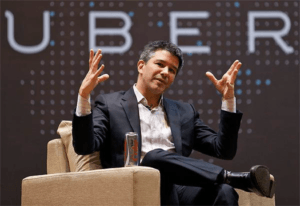Detroit In the Rear-view Mirror: How Uber will Commoditize Cars

Does Uber’s rise mean automakers’ demise?

Understanding the big picture
The first time I used Uber in 2012, I was trying to get to Dulles Airport from a DC suburb. After a few minutes riding in the black car – the only option at the time – I remember thinking “this is so much better than a DC taxi experience!” I didn’t need to call the cab company three times to verify it was still on its way 15 minutes after ordering it. I didn’t need to debate the payment method with the driver. I didn’t need to explain how to get to my destination. I was in good company thinking that Uber might replace taxis. What I didn’t see was that they would begin to replace car ownership too.
Uber delivers convenience
Uber can deliver the benefits of cars, without many of car ownership’s traditional pain points. Because consumers interact with Uber through their smartphone, a ride can be summoned from anywhere to anywhere. A warmed-up and air-conditioned vehicle arrivers at the consumer’s feet within minutes, rather than the consumer needing to walk to where they parked the car – which could take as long or longer. So far Uber is at least par with car ownership. However, with Uber consumers don’t have to drive, park, insure, refuel, or repair. Uber drivers take care of all those non-value-added steps on their own time and their own dime.
Pricing: an economist’s dream
The consumer is still indirectly paying for the driving, parking, insurance, and refueling (although the ride’s price might not be fully covering driver’s costs), but the price is set based on the demand for rides and the supply for drivers. After facing backlash from consumers on “surge pricing”, Uber has simplified their message and now just displays the price of the ride to the consumer who then elects whether to order.
Keeping it light
If car ownership is viewed as a bundle of rides, then Uber has effectively unbundled the service and the pricing, allowing consumers to pay as they go rather than making a large, long term asset purchase up front. In this sense, they have taken the car rental unbundling model and pushed it to a far more granular level. At the same time they have remained far less capital intensive than both carmakers and rental companies because Uber does not need to own a fleet of vehicles.
Ownership won’t disappear, but carmakers should worry
Uber has a long way to go to replace car ownership entirely, and currently ride-sharing is more of a complement to ownership than a substitute. The demand for cars continues even through Uber drivers, but the premise behind ride-sharing is that a smaller fleet of vehicles can service the same population through the efficiency of matching seats to riders. While rural consumers will continue to buy cars, urbanization means overall car-buying rates might hold steady or even drop. Self-driving vehicles exacerbate the trend by lowering the cost of rides in the long term and increasing the number of hours a car is used in a day. The brighter the future for Uber, the bleaker for automakers.
Sources:
https://www.washingtonpost.com/news/get-there/wp/2015/02/20/the-hidden-costs-of-being-an-uber-driver/
http://www.businessinsider.com/uber-stops-showing-surge-pricing-rates-2016-6
http://fortune.com/2016/08/24/uber-volvo-car-ownership/



Hi AlmostFirst! Great article! I do agree with you that car ownership will be completely transformed in the future and to an extent car would be commoditized. However, the question that I have is whether Uber would be able to capture the most value from this transformation? Or are there other companies that might end up doing so. For e.g. Tesla and Google are investing a lot in self driving cars and I think these type of cars would be responsible for ridesharing model in the future. I agree Uber has the first mover advantage but I am curious to know your views on whether they would be able to sustain this advantage in the future?
Great post! For many years it seemed the Uber would become the only remaining ride-share company given the clear network effects. With the challenges in China (Didi) and persistence of Lyft and others, that assumption has been called into question. Additionally, the model has still struggled to show growth in areas without significant density. It seems that eventually Uber will prevail, but questions around labor disputes and Uber’s profit model may limit the overall amount of value created. Any thoughts on the additional services that Uber is looking to layer on top of the ride-matching software?
Very interesting. I agree that we have a long way until ridesharing displaces car ownership. If you will entertain me, however, I’d like to imagine a world where all cars go from a product to a shared service. In that reality, should uber’s revenue model change? To what? Thanks!
Thank you AlmostFirst. I am also fascinated by the transportation revolution that Uber has brought to us. They have certainly secured a safe beachhead from where they could spearhead into new businesses. Is there a risk for Uber to become fairly asset heavy business down the line and resemble more an airline than technology company. Should they leverage their data and technological edge to navigate around the tempting alternative of owning large car fleets?